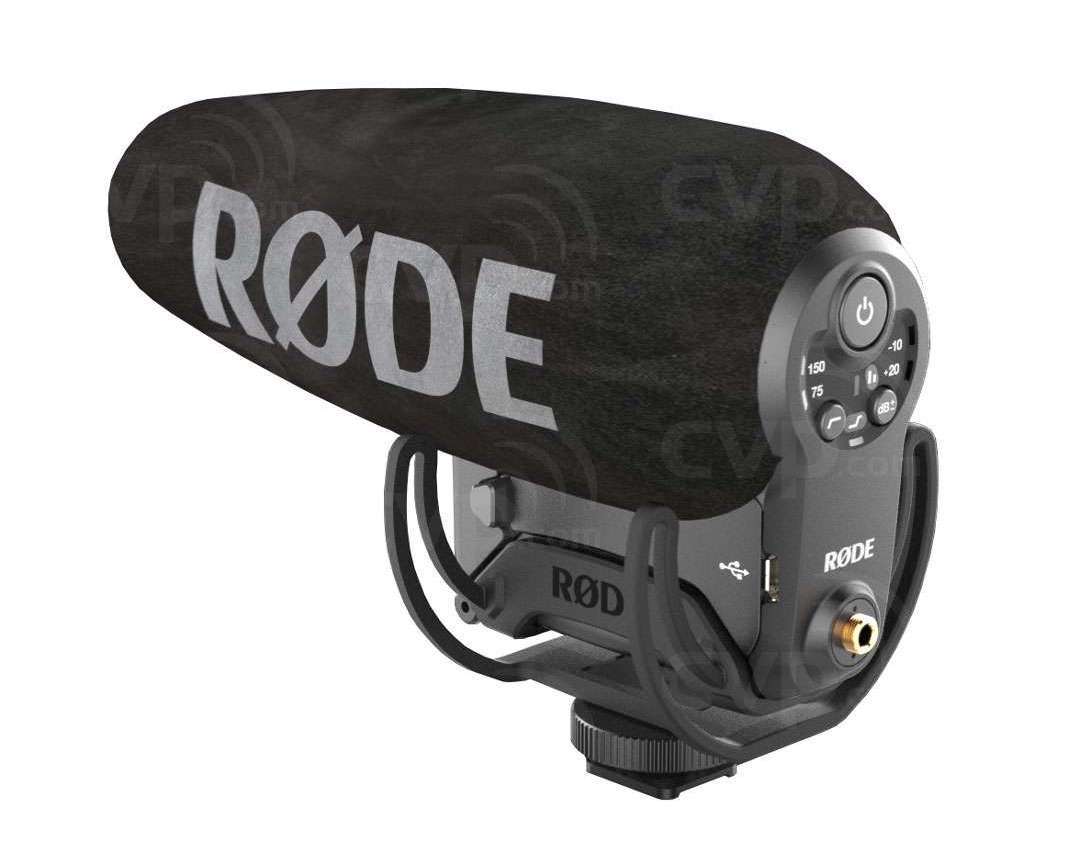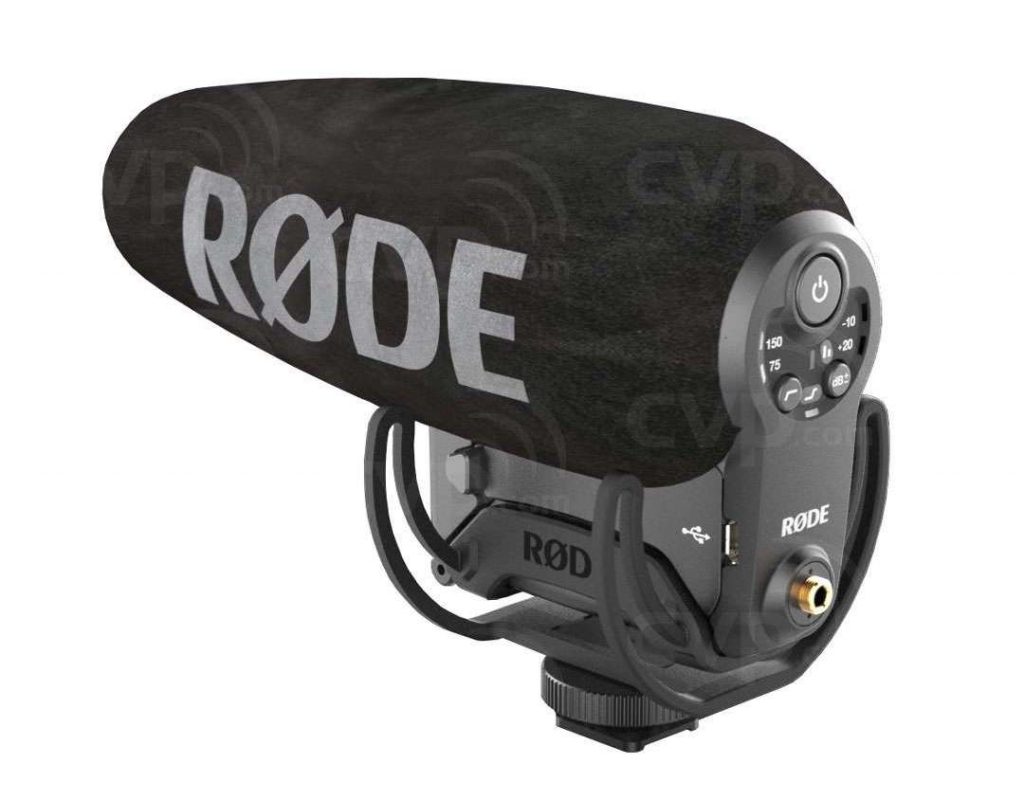
For many years, I have been reviewing several different types of microphones. However, this is the very first time I am focusing on the on-camera genre. One of the most popular one has been the VideoMic Pro from RØDE. Now the Australian manufacturer has taken it to the next level with the VideoMic Pro+. Ahead I’ll go over each one of the specific new features, including two videos from RØDE and four more audio/video test recordings shot with Sony PXW-X70. Finally, I include what I call “The Moral of the Story” regarding on-camera mics as opposed to their alternatives.
RØDE describes the RØDE VideoMic Pro+ as:
“A new addition to the best-in-market on-camera category. It is a true shotgun microphone designed for use with camcorders, DSLR cameras and portable audio recorders as a source of primary and reference audio.”
Even though RØDE didn’t mention it, RØDE VideoMic Pro+ will also work with mirrorless cameras and PTZ (pan/tilt/zoom) cameras with mic inputs too.
Audio connection and signal
The VideoMic Pro+ (B&H link) terminates with a TRS (Tip Ring Sleeve) 3.5 mm plug. See my TS/TRS/TRRS/TRRRS: Combating the misconnection epidemic article (illustrated above) for more details about the different types of plugs.
Although a TRS plug often means “stereo”, the VideoMic Pro+ is not a stereo microphone. It is mono. It has a TRS plug for two reasons:
- Most video camcorders with a 3.5mm mic input have a TRS socket and are expecting a TRS plug, since some people might connect a stereo mic, or record dual mono with an appropriate adapter.
- There is a special function on the VideoMic Pro+ for audio bracketing where, one of the two “stereo” channels is reduced in level, as a spare. This can be helpful when shooting unrepeatable and unpredictable content and an unexpected extremely loud signal causes clipping, but requires proper selection during editing to be useful between the main and spare track. I did not test this option during the recordings, since what we did was both repeatable and predictable. When not invoking the audio bracketing feature, the VideoMic Pro+ outputs an identical signal on its Left and Right channels on the TRS plug.
In other scenarios, the TRS plug on the VideoMic Pro+ can certainly be adapted to TRRS (for direct connection to a smartphone or tablet) using an optional SC4 adaptor (Amazon link • B&H link). The VideoMic Pro+ can also be adapted to XLR using an optional VXLR adaptor (Amazon link • B&H link).
For the test recordings you will see and hear ahead in this article, we didn’t use any adapter. Instead, we temporarily removed the handle (with its XLR inputs) from the Sony PXW-X70 camcorder (Amazon link • B&H link) and mounted the VideoMic Pro+ directly onto the camera body’s onboard shoe. We then connected the VideoMic Pro+’s TRS plug directly into the Sony PXW-X70 camcorder’s own 3.5 mm input.
Automatic on/off power with options
RØDE understands that with the stress of audio/video production, it is natural to forget to shut off a microphone when you shut off a camera. When camera operators forget to do that, the microphone (with built-in batteries) continues to draw power and suck the batteries dry even when not being used to record or broadcast live. That’s why RØDE invented an automatic function that can automatically shut off the microphone when the microphone stops receiving bias voltage (aka plugin power) from the camera, i.e. when the camera operator shuts off the camera or unplugs the mic. So whenever used with a camera that outputs bias voltage on the mic input, there is no longer any need to remember to turn the microphone off, since it shuts off automatically. Of course, there is a button to turn the microphone on and off manually, in the case of using the mic with a camera or other device that doesn’t output bias voltage.
The VideoMic Pro+ comes with its included LB-1 lithium-ion rechargeable battery, and alternatively can be powered continually via Micro USB. In addition, the VideoMic Pro+ can also accept AA batteries.
Built-in shock absorber
The VideoMic Pro+ has a built-in Rycote Lyre suspension system, which has been called “best in class”.
Built-in pre-preamp
To compensate weak and noisy preamps (preamplifiers) in many cameras, the VideoMic Pro+ has a built-in pre-preamp, similar to other’s I have covered in the past, including Cloudlifter and Fethead (although those two are for balanced mics where the connected device offers phantom power). The VideoMic Pro+ offers up to +20dB of pre-preampfification. This allows setting the camera’s audio input level to minimum.
Built-in filter and equalization
The VideoMic Pro+ has a built-in two-stage low cut (aka high pass) filter to reduce low frequencies such as rumble from traffic or air conditioning.
In addition, the VideoMic Pro+’s high frequency boost can raise high frequencies when desired, enhancing detail and clarity in the recording.
Two videos from RØDE
Four test videos
The following 4 test videos were shot by Francisco Javier Arbolí using his PXW-X70. As indicated earlier, we removed the PXW-X70’s handle with XLR in order to mount the VideoMic Pro+ directly to the camera, and connected the TRS 3.5 mm plug directly into the matching input on the camera. Audio in the camera was set to manual. Video was shot at 1080/29.97p at 50 megabits per second 10-bit 4:2:2 using Sony’s XAVC L códec with uncompressed audio. Later, I used Telestream Switch (reviewed in three articles here) to transcode to Apple ProRes 4:2:2. I then used Auphonic to normalize the audio to -16 LUFS (without any filtration). I edited with Telestream ScreenFlow 6.2.3, where I moved the video saturation to zero (to get the grayscale effect) and added each lower third, which is a PNG with alpha channel created externally.
I shot the still photo of Francisco Javier Arbolí with his camcorder and the VideoMic Pro+ using my Google Pixel XL (Amazon link) phone’s native Camera app in Android 8.0 (Oreo), and converted it to grayscale using the web version of Google Photos. Since the original photo is 4048×3036, I scaled it down to 1920×1080 in ScreenFlow with a slight crop.
The required audio boost to -16 LUFS during normalization of all clips was moderate with most, since the raw recordings made with the VideoMic Pro+ were approximately -21 LUFS. However the required boost from the only one made with the PVW-X70 camcorder’s built in mic was much greater, since the raw recording was -30.89 LUFS and that was already maxed out with the camera’s manual audio level adjustment.
VideoMic Pro+ flat with +20dB pre-gain in the mic:
VideoMic Pro+ with 75Hz low cut filter and +20dB pre-gain in the mic:
VideoMic-Pro+ 150Hz low cut filter and high-frequency-boost and +20dB pre-gain in the mic:
Sony PXW-X70 camcorder internal mic, for comparison
Conclusions and “The Moral of the Story”
Many people who haven’t tried them yet have an extremely high expectation for an on-camera mic. Those people then become disappointed until they finally realize that no matter how good or how directional a microphone is, the closer to the source the better. No on-camera mic can compete with a mic which is much closer to the individual speaking, be it:
- a head mounted mic, like these two I recently reviewed
- A handheld mic, like the RØDE Reporter (reviewed here, Amazon link • B&H link) or Senal ENG-18RL (reviewed here, B&H link)
- a lavalier mic
- on a boom just out of frame
On-camera mics are good as supplementary audio and/or when none of the above is feasible. With the VidMic Pro+ (B&H link), RØDE has made it become the best in its category, but it is still that category.
Upcoming articles, reviews, radio shows, books and seminars/webinars
Stand by for upcoming articles, reviews, and books. Sign up to my free mailing list by clicking here. Most of my current books are at books.AllanTepper.com, and my personal website is AllanTepper.com.
Si deseas suscribirte a mi lista en castellano, visita aquí. Si prefieres, puedes suscribirte a ambas listas (castellano e inglés).
Listen to his CapicúaFM show at CapicúaFM.com or subscribe via Apple Podcasts, Radio Public or Stitcher.
Save US$20 on Project Fi, Google’s mobile telephony and data
Click here to save US$20 on Project Fi, Google’s mobile telephone and data service which I have covered in these articles.
Learn to speak Castilian, the most widely used Spanish language
FTC disclosure
No manufacturer is specifically paying Allan Tépper or TecnoTur LLC to write this article or the mentioned books. Some of the other manufacturers listed above have contracted Tépper and/or TecnoTur LLC to carry out consulting and/or translations/localizations/transcreations. Many of the manufacturers listed above have sent Allan Tépper review units, including RØDE. So far, none of the manufacturers listed above is/are sponsors of the TecnoTur programs, although they are welcome to do so, and some are, may be (or may have been) sponsors of ProVideo Coalition magazine. Some links to third parties listed in this article and/or on this web page may indirectly benefit TecnoTur LLC via affiliate programs. Allan Tépper’s opinions are his own.
Copyright and use of this article
The articles contained in the TecnoTur channel in ProVideo Coalition magazine are copyright Allan Tépper/TecnoTur LLC, except where otherwise attributed. Unauthorized use is prohibited without prior approval, except for short quotes which link back to this page, which are encouraged!

